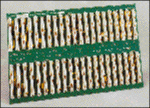VME backplane technology transfers data at 320 Mbytes/s
Backplane manufacturer Bustronic (Fremont, CA) and backplane designer
Arizona Digital (Scottsdale, AZ) recently revealed the technology behind
their patent-pending VME320 backplane (see photo ). The new backplane,
which transfers data at a rate of 320 Mbytes/s, is claimed to be more than
five times faster than conventional VME64 backplanes. However, unlike such
high-performance approaches as the extended VME64, the VME320 is fully
forward and backward compatible with the existing base of VME boards and
can be manufactured at essentially the same cost.

Fully forward and backward compatible with VME systems, the VME320
ultra-high-speed backplane is offered as being easy to use and less expensive than
other high-performance backplanes.
The internal construction of the VME320 backplane differs significantly
from conventional VME backplanes. Conventional backplanes are wired from
slot to slot so that a given pin in each connector is stitched to the next
connector and so on down the backplane until all such pins are connected.
This type of bus acts as a transmission line with distributed inductance
and capacitance. When the circuit boards are plugged in, their additional
stub and circuit capacitance makes the bus act as a very low-impedance
transmission line with a very slow propagation time.
The VME320 instead runs a signal trace from slot 1 to slot 11, a separate
trace from slot 2 to slot 11, another trace from slot 3 to slot 11, and
continues until all slots have been wired to the common point at slot 11.
Therefore all of the trace capacitance, the stub capacitance, and the circuit
capacitance appear to be concentrated at slot 11 rather than distributed
as in the conventional backplane. The result is that the equivalent circuit
of the backplane is a simple lumped 200-pF capacitance–not a transmission
line. When the circuit cards are added, the equivalent circuit doesn't
change–it just appears as a larger lumped capacitance.
Because the backplane acts as a lumped capacitance, the rise and fall
times of the signals are very clean and monotonic–that is, they transition
through the switching threshold without hanging or changing direction.
This allows a faster signaling protocol, such as source synchro- nous transfer,
to be used.
With traditional backplanes, the stub length and transceiver capacitance
of each circuit card are the most significant variables affecting backplane
signal integrity. With VME320 backplanes, however, these factors are relatively
unimportant–they merely affect the signal rise and fall times, but not
the signal integrity. In addition, the VME320 backplane is also very quiet
and produces little crosstalk.
The backplane is also available in a 160-Mbytes/s version, the VME160.
For more information, call Fred Hirsch of Bustronic at 510-490-7388 or e-mail
him at fhirsch@bustronic.com .
–Matthew Eisenberg
Advertisement





